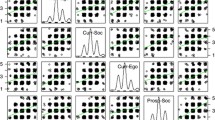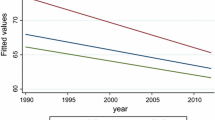5. Summary and conclusions
The central hypothesis of the economic model of voter participation was put to an empirical test. It was found that the coefficient of population size, which represents the subjective probability of affecting election results, is negative and significant in municipal local elections, but insignificant in national Knesset elections. Therefore, this variable is unable to represent subjective probability in the latter case.
It was suggested that the economic model is more relevant to local elections than to Knesset elections. The empirical results revealed that the regression coefficients of municipal elections that took place separately from Knesset elections fit the expected outcome of the economic model whereas when municipal elections were held simultaneously with the Knesset election this did not hold true.
Similar content being viewed by others
REFERENCES
Bary, B. (1970). Sociologists, economists and democracy. Collier-Macmillan.
Barzel, Y., and Silberberg E. (1973). Is the act of voting rational. Public Choice.
Cassel, C.A., and Hill, D.B. (1981). Explanation of turnout declines. American Political Quarterly.
Chamberlain, G., and Rothchild, M. (1981). A note on the probability of casting a decisive note. Journal of Economic Theory.
Ferejohn, J.A., and Fiorida, M.P. (1974). The paradox of not-voting: A decision theoretic analysis. The American Political Science Review.
Filler, E.F., and Kennedy, L.W. (1980). Voter turnout and the benefit of voting. Public Choice.
Frey, S.B. (1972). Why do high income people participate more in politics. Public Choice.
McKenzie, R.B. (1980). Economic issues in public policies, Ch. 12. McGraw-Hill.
Milbrath, L.W. (1965). Political participation. Chicago: Rand-McNally.
Riker, W.H., and Ordeshook, P.C. (1968). A theory of the calculus of voting. American Political Science Review.
Rosenberg, J., and Darvish, T. (1985). The relevance of the economic approach to election turnout: Some comments. Bar Ilan University, unpublished.
Tollison, R.D., and Willet, T.D. (1973). Some simple economics of voting and not voting. Public Choice.
Author information
Authors and Affiliations
Additional information
The authors wish to thank Joseph Tempelman for several helpful suggestions.
Rights and permissions
About this article
Cite this article
Darvish, T., Rosenberg, J. The economic model of voter participation: A further test. Public Choice 56, 185–192 (1988). https://doi.org/10.1007/BF00115757
Issue Date:
DOI: https://doi.org/10.1007/BF00115757




